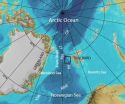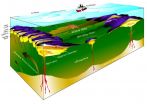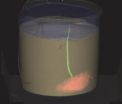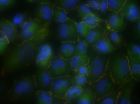(Press-News.org) Methane, a highly effective greenhouse gas, is usually produced by decomposition of organic material, a complex process involving bacteria and microbes.
But there is another type of methane that can appear under specific circumstances: Abiotic methane is formed by chemical reactions in the oceanic crust beneath the seafloor.
New findings show that deep water gas hydrates, icy substances in the sediments that trap huge amounts of the methane, can be a reservoir for abiotic methane. One such reservoir was recently discovered on the ultraslow spreading Knipovich ridge, in the deep Fram Strait of the Arctic Ocean. The study suggests that abiotic methane could supply vast systems of methane hydrate throughout the Arctic.
The study was conducted by scientists at Centre for Arctic Gas Hydrate, Environment and Climate (CAGE) at UiT The Arctic Univeristy of Norway. The results were recently published in Geology online and will be featured in the journal's May issue.
Previously undescribed
"Current geophysical data from the flank of this ultraslow spreading ridge shows that the Arctic environment is ideal for this type of methane production. " says Joel Johnson associate professor at the University of New Hampshire (USA), lead author, and visiting scholar at CAGE.
This is a previously undescribed process of hydrate formation; most of the known methane hydrates in the world are fueled by methane from the decomposition of organic matter.
"It is estimated that up to 15 000 gigatonnes of carbon may be stored in the form of hydrates in the ocean floor, but this estimate is not accounting for abiotic methane. So there is probably much more." says co-author and CAGE director Jürgen Mienert.
Life on Mars?
NASA has recently discovered traces of methane on the surface of Mars, which led to speculations that there once was life on our neighboring planet. But an abiotic origin cannot be ruled out yet.
On Earth it forms through a process called serpentinization.
"Serpentinization occurs when seawater reacts with hot mantle rocks exhumed along large faults within the seafloor. These only form in slow to ultraslow spreading seafloor crust. The optimal temperature range for serpentinization of ocean crust is 200 - 350 degrees Celsius." says Johnson.
Methane produced by serpentinization can escape through cracks and faults, and end up at the ocean floor. But in the Knipovich Ridge it is trapped as gas hydrate in the sediments. How is it possible that relatively warm gas becomes this icy substance?
"In other known settings the abiotic methane escapes into the ocean, where it potentially influences ocean chemistry. But if the pressure is high enough, and the subseafloor temperature is cold enough, the gas gets trapped in a hydrate structure below the sea floor. This is the case at Knipovich Ridge, where sediments cap the ocean crust at water depths up to 2000 meters. " says Johnson.
Stable for two million years
Another peculiarity about this ridge is that because it is so slowly spreading, it is covered in sediments deposited by fast moving ocean currents of the Fram Strait. The sediments contain the hydrate reservoir, and have been doing so for about 2 million years.
" This is a relatively young ocean ridge, close to the continental margin. It is covered with sediments that were deposited in a geologically speaking short time period -during the last two to three million years. These sediments help keep the methane trapped in the sea floor." says Stefan Bünz of CAGE, also a co-author on the paper.
Bünz says that there are many places in the Arctic Ocean with a similar tectonic setting as the Knipovich ridge, suggesting that similar gas hydrate systems may be trapping this type of methane along the more than 1000 km long Gakkel Ridge of the central Arctic Ocean.
The Geology paper states that such active tectonic environments may not only provide an additional source of methane for gas hydrate, but serve as a newly identified and stable tectonic setting for the long-term storage of methane carbon in deep-marine sediments.
Need to drill
The reservoir was identified using CAGE's high resolution 3D seismic technology aboard research ressel Helmer Hanssen. Now the authors of the paper wish to sample the hydrates 140 meters below the ocean floor, and decipher their gas composition.
Knipovich Ridge is the most promising location on the planet where such samples can be taken, and one of the two locations where sampling of gas hydrates from abiotic methane is possible.
" We think that the processes that created this abiotic methane have been very active in the past. It is however not a very active site for methane release today. But hydrates under the sediment, enable us to take a closer look at the creation of abiotic methane through the gas composition of previously formed hydrate." says Jürgen Mienert who is exploring possibilities for a drilling campaign along ultra-slow spreading Arctic ridges in the future.
INFORMATION:
Researchers at Uppsala University have, together with researchers from Turku and Bergen, discovered a new biomarker which makes it possible to identify women with uterine cancer who have a high risk of recurrence. The findings were recently published in the journal Gynecologic Oncology.
Endometrial cancer of the uterus is the most common form of gynecologic cancer in Europe and North America. The treatment primarily consists of removing the uterus and in some cases offering chemotherapy if the risk of recurrence is deemed high.
The current study looks at the amount ...
Researchers at the University of Manchester and Central Manchester University Hospitals NHS Foundation Trust have published data for the first time about public knowledge of and interest in the process of medicines research and development.
The study, which is part of the wider European Patients' Academy on Therapeutic Innovation (EUPATI) project, is believed to be the largest peer-reviewed survey of its kind and was published today in the BMJ Open.
Medicines R&D describes the entire process of bringing a new medicine to patients - from laboratory studies to clinical ...
The seabed is inhabited by vast numbers of small animals with hidden lives in the sandy sediments. Here they play an important role in keeping the oceans healthy. But how these animals behave and interact with each other is unclear, as it is not possible to see them without disturbing the sediment.
Researchers like Ph.D. Matthieu Delefosse would enjoy putting on a pair of X-ray glasses and study the sediment living animals without disturbing them.
"We know bits and pieces of what these animals do through different measurements/experiments, but we do not have an integrated ...
Researchers at Genes and Cancer group at Bellvitge Biomedical Research Institute (IDIBELL), led by Montse Sanchez-Cespedes, have identified the PARD3 gene as a tumor suppressor that is inactivated in lung cancer squamous type. The results of the study have been published in Cancer Research.
Correct polarization (orientation in space) of bronchial epithelial cells is essential for the maintenance and proper development of this tissue under normal conditions.
PARD3 gene encodes a protein that regulates cell polarization and cell junctions. When the gene is inactivated, ...
Scientists at the University of Sheffield calculate that all of the UK's high level nuclear waste from spent fuel reprocessing could be disposed of in just six boreholes 5km deep, fitting within a site no larger than a football pitch.
The concept - called deep borehole disposal - has been developed primarily in the UK but is likely to see its first field trials in the USA next year. If the trials are successful, the USA hopes to dispose of its 'hottest' and most radioactive waste - left over from plutonium production and currently stored at Hanford in Washington State ...
Simply declaring a region as a nature protection area is not enough, regular monitoring of its ecological condition is also necessary. Since Nature protection areas already cover almost one fifth of the surface of the European Union, it is impossible to inspect such a vast area in the traditional way on foot. Therefore, new methods are being developed to monitor Europe's nature protection areas from the air. Short laser pulses are sent to the ground, and information on the status of the habitat can be deduced from the reflected light signals using elaborate computer algorithms.
Laser ...
Cancer Mortality Reductions Were Greatest Among Countries Where Cancer Care Spending Rose The Most, 1995-2007.
Warren Stevens of Precision Health Economics, Dana P. Goldman of the Schaeffer Center for Health Policy and Economics at the University of Southern California, and coauthors compared cancer care across sixteen countries over time, examining changes in cancer spending and two measures of cancer mortality (amenable and excess mortality). They found that, compared to low-spending health systems, high-spending systems had consistently lower cancer mortality in the ...
Fast Facts:
More than 30,000 people in the U.S. are diagnosed with Lou Gehrig's disease, or amyotrophic lateral sclerosis (ALS).
Johns Hopkins researchers have transformed skin cells donated by ALS patients into brain cells affected by the progressive, fatal disease.
The resulting cell library is being used by researchers worldwide in the quest for better ALS treatments.
Researchers at Johns Hopkins Medicine have transformed skin cells from patients with Lou Gehrig's disease, or amyotrophic lateral sclerosis (ALS), into brain cells affected by the progressive, ...
The World Health Organization (WHO) have announced a new statement on the public disclosure of clinical trial results which updates and expands a previous statement that noted the "the registration of all interventional trials is a scientific, ethical, and moral responsibility." The new statement includes timelines by which researchers are expected to report clinical trials results. In an Essay published in this week's PLOS Medicine Vasee Moorthy and colleagues from the WHO outline the rationale behind the new statement.
A new element in the WHO statement is the definition ...
Extreme hazards - rare, high-impact events - pose a serious and underestimated threat to humanity. The extremes of the broad ensemble of natural and anthropogenic hazards can lead to global disasters and catastrophes. Because they are rare and modern society lacks experience with them, they tend to be ignored in disaster risk management. While the probabilities of most natural hazards do not change much over time, the sensitivity of the built environment and the vulnerability of the embedded socio-economic fabric have increased rapidly. Exposure to geohazards has increased ...





